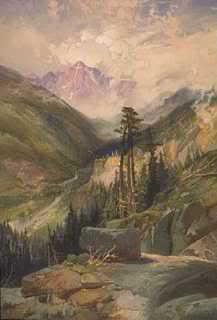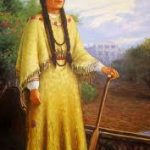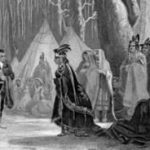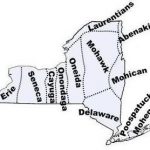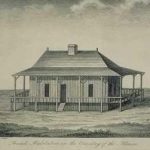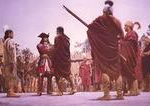The Year: 1727
Elizabeth Catherine Montour, better known as Madame Montour, was born in 1667 at Three Rivers, Canada, the daughter of Frenchman Pierre Couc and his Algonquin Native American wife (name unknown). Madam Montour spent several years in the early 1700s at Forts Mackinac and Detroit where her relatives were engaged in the Indian trade.
Catherine acquired the Montour surname when she married a Seneca brave named, Roland Montour. He appears to have been the father of some of her children, but little is known about him, not even details of his death. By this point in her life, she was known as Madame Montour, was living in New York in the area of the Genesee River.
It is believed that she traveled to the Albany area in 1709 with her brother, Louis, where he served as an interpreter. That same year, while he was conducting Indians to trade in Albany, Louis was murdered, and Madame Montour was employed by New York Governor Robert Hunter to take his place.
Madame Montour remained in New York and, because of her knowledge of various European and Indian languages – English, German, Algonquin, and Iroquois, and French – she worked as an interpreter for the English colonies from that time on. In 1727, she was an interpreter at a council in Philadelphia. Her work was so valued by the authorities that she was paid the same as a man.
Although no date is recorded, Madame Montour married her second husband, an Oneida chief named Carondowanna. Madame Montour and Carondowanna then migrated to Otstuagy, now Montoursville, Pennsylvania. Her second husband was killed in the Carolinas in a battle with the Catawba in the spring of 1729.
From the time of her second husband’s death, until her death in the late 1740s, Madame Montour was recognized as a great leader of her people in the West Branch Susquehanna River Valley.
Madame Montour’s village, Otstuagy, became a vitally important location during the settlement of what is now Montoursville. Her village, at the mouth of Loyalsock Creek on the West Branch Susquehanna River, was an important stopping point for the Moravian missionaries, who were spreading the gospel throughout the wilderness of Pennsylvania during the 1740s.
Madame Montour was known to be a friend to the British, and welcomed the white men who were beginning to migrate into the West Branch Susquehanna River Valley. She also had a great amount of influence with the various Indian tribes who were feeling the pressure of colonial expansion. Madame Montour remained loyal to the British despite several attempts by the French to bring her over to their side.
Elizabeth Catherine Montour was the mother of three children. Her son, Louis, served as an interpreter during the French and Indian War, and was killed during the war. Her daughter, Margaret, later to be known as “French Margaret” went on to become the leader of “French Margaret’s Town,” an Indian settlement at the mouth of Lycoming Creek, just a few miles up the West Branch Susquehanna River from Montoursville.
Interviewed in 1744, at the age of 77, Witham Marshe wrote of Madame Montour: “She has been a handsome woman, genteel and of polite address.”
Madame Elizabeth Catherine Montour died in the late 1740s, and her son Andrew took over leadership of Otstuagy.
Andrew Montour
Catherine’s son Andrew Montour was one of the most important interpreters and negotiators in the Virginia and Pennsylvania backcountry in the 1750s and 1760s. Andrew inherited his mother’s gift for languages. He spoke French, English, Lenape, Shawnee, and the Iroquoian language.
Comfortable with both Native Americans and Europeans, he made a good living as a translator for both settlers and local tribes. So strong was his influence with tribes in the Ohio River Valley that the French put a bounty on his head. Montour was murdered by a Seneca Indian in 1772.
He was granted 880 acres of land by the Province of Pennsylvania in the Montoursville area. He was appointed as a captain in George Washington’s Army at Fort Necessity during the French and Indian War.
SOURCES
Elizabeth Catherine Montour
